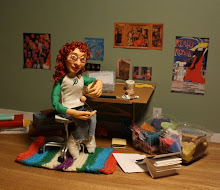
I think you have to be a certain type of person to read books about the visual as so much depends upon the the imagination of the reader. Mike Wilkes' Mirrorscape requires of those readers.
Melkin Womper, a boy from a small town, is scooped up by Ambrosius Blenk, the greatest painter of the day, and given an apprenticeship. But things are not as rosy as they seem. Color, music, delicious food, anything which might be considered a luxury is extremely expensive and controlled by the Mysteries, and the Mysteries hold many secrets and much corruption. Mel and his friends Wren and Ludo find themselves in the thick of Mystery secrets in an adventure that will bring them into the Mirrorscape- the world within paintings.
Wilkes' book is heavy with description, detailing paintings, drawings, and bestiary illustrations. For readers unfamiliar with art, the book may be confusing, and I suggest looking at examples of medieval bestiary reproductions, Bosch paintings, and an Escher or two before delving into the book. Some of the creatures and environments within the Mirrorscape are confusing, as they are only elucidated with words. Seeing artworks beforehand may spark the reader's mind as s/he imagines Mel's world.
Mirrorscape is the first in a series that promises to mix magic with the visual arts. But it's not the fast-paced plot many readers are used to. Yes, the plot is thick with devilry, but simple resolutions are a long time coming. In places, vital descriptions trip up the adventure like disproportionate figures in a beautifully realized setting. Though the book is suggested for those twelve and up, and the character of Mel is about this age, the density of description recommend it for an older audience or a particularly patient reader.
After reading Mirrorscape, I got to thinking about stories that are intrinsically visual. I read A.S. Byatt's The Children's Book while independently studying art in Europe. I became lost in Byatt's descriptions of art and the creative process, and began trying to describe my creative process. Byatt captured something in her descriptions of the power and energy an artist thrusts into his/her work, something I don't realize until I've stopped working and view the unfamiliar work in front of me through the haze of hunger and watering eyes. The only other story that came to mind is the Chinese myth of the magic paintbrush, though I think Patricia McKillip may have an embroidery-based fairy tale. It's certainly a topic I'd like to look into further.

No comments:
Post a Comment